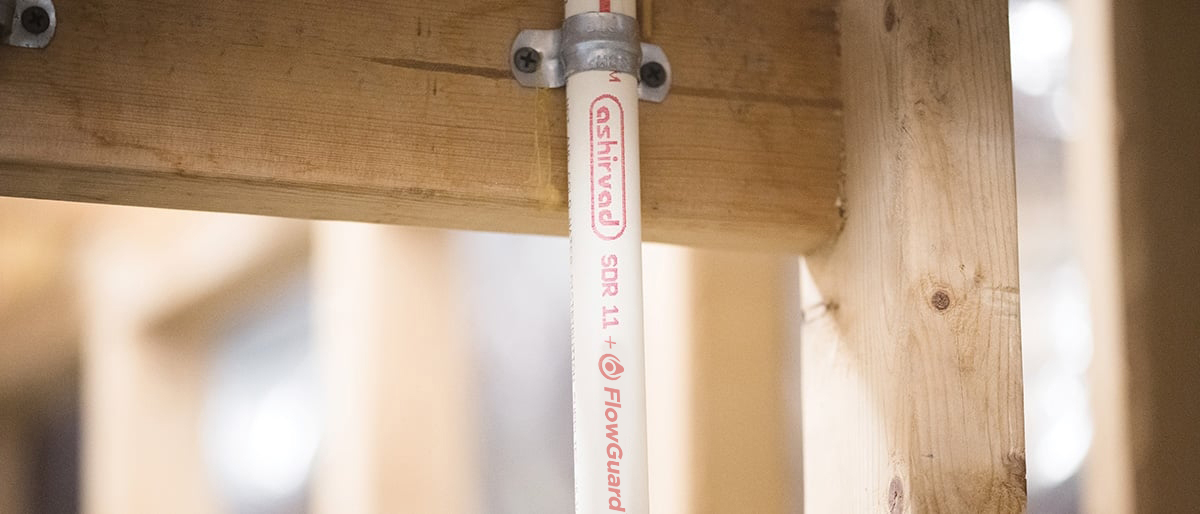
15 Tips for a Successful CPVC Installation
Expert advice on Plumbing CPVC Pipes and Fittings
Chlorinated polyvinyl chloride (CPVC) pipe and fitting installation is quick and cost-effective. Pipes are joined with an easy solvent cement welding process and inexpensive, with readily available tools.
Additionally, CPVC installations are much simpler and easier than conventional piping systems as this does not require heavy tools or welding, which allows for easy installation in tight, confined spaces.
Following best practices for FlowGuard® Plus Plumbing system installation will ensure a reliable, long-lasting plumbing system.
The tips highlighted below do not replace the manufacturer’s instructions, but provide a list of helpful dos and don’ts.
Storage and Handling
Although FlowGuard Plus CPVC is durable, practice proper care and storage for successful installation.
- Tip #1: Store pipe on flat areas, free of sharp jagged rocks or debris that could puncture or damage the pipe. Additionally, never set anything heavy, sharp or rough on top of the piping.
- Tip #2: Keep piping covered when exposed to UV light, such as when storing it outside. Although some exposure to UV won’t damage piping, we still recommend covering piping with a non-transparent material.
- Tip #3: Avoid storing CPVC pipe in high-traffic areas. Never store piping in areas where heavy power equipment is moved around. Although CPVC is a strong material, running over the pipes with heavy machinery can cause damage.
Preparing For Installation
While CPVC installation is fairly simple, a few safeguards will ensure a reliable system.
- Tip #4: Wear safety gear & keep away from Fire: Solvent cement contains flammable solvents, hence care should be taken to keep away from flame while using. Additionally, avoid direct contact on skin and eyes.
- Tip #5: Wipe away any dirt or moisture from the pipe and fittings using a dry cloth, to ensure a strong solvent cemented bond.
- Tip #6: Inspect the pipe before and after cutting. There should be no visible cracks or damage. If damage is present, measure 5 centimetres from the end of the crack and recut the pipe.
- Tip # 7: Do a dry fit to examine fit of pipe in fittings: Push the pipe inside the fitting and discard the fitting if there is a play or the pipe bottoms out in the piping without resistance
- Tip #8: Use an appropriate tool to ensure a square cut and maximize the bonding surface. Use a sharp circular saw, miter saw, hand saw or ratchet cutter and make sure the blade is fine toothed (6 to 7 teeth per centimetre.)
- Tip #9: Bevel the pipe prior to solvent welding. Use a bevelling tool, to create a slight bevel along the pipe edge. In the absence of a bevelling tool, sandpaper may be used. This shall prevent the solvent cement from being pushed down into the fitting.
During Installation
When installed properly, newly formed joints become the strongest part of the system. To achieve this result, abide by a few standby rules.
- Tip #10: Try to join seams in cooler areas or shade. Heat can increase how quickly solvent cement evaporates. CPVC plumbing fittings and pipes should only be joined while the solvent cement is in a flowing state, so stay in a cool area to make sure the solvent cement doesn’t begin to dry before you’re ready to join the pipe and fitting.
- Tip #11: Allow the joint to set before moving forward. Properly align the fitting and hold the assembly for 10 seconds.
- Tip #12: Never re-apply over dried solvent cement. If solvent cement dries before you’ve bonded the pipe and fitting, recut the pipe or use a different pipe and fitting.
- Tip #13: Use the correct cure time. FlowGuard Plus CPVC cure times vary based on temperature, humidity, and pipe size. Refer to the solvent cement manufacturer’s manual for specific times. The FlowGuard Pipe and Fittings Installation Guide also provides general time suggestions, but shouldn’t replace manufacturer instructions.
- Tip #14: Always look for an even bead of cement around the newly-formed joint. If the bead is not visible, then solvent cement might not have been properly applied. If this is the case, remake the joint to ensure system integrity.
- Tip #15: Pressure test the system: Post curing period, always pressure test the systems as per local standards and manufacturers specifications.
Want to Learn More Tips For Installing FlowGuard® Plus CPVC?
Check out the full FlowGuard Plus Pipe and Fittings Installation Guide for additional installation instructions, including proper storage and handling, cure time recommendations and using hangers and supports.
If you have any questions about FlowGuard Plus CPVC plumbing pipe and installation, our team of piping system consultants is ready to talk.

Prasenjit Misra
Prasenjit Misra, an accomplished professional, having extensive exposure in plumbing field, currently holds the position of Lead Demand Creation & Business Development of TempRite South Asia division at Lubrizol India.
